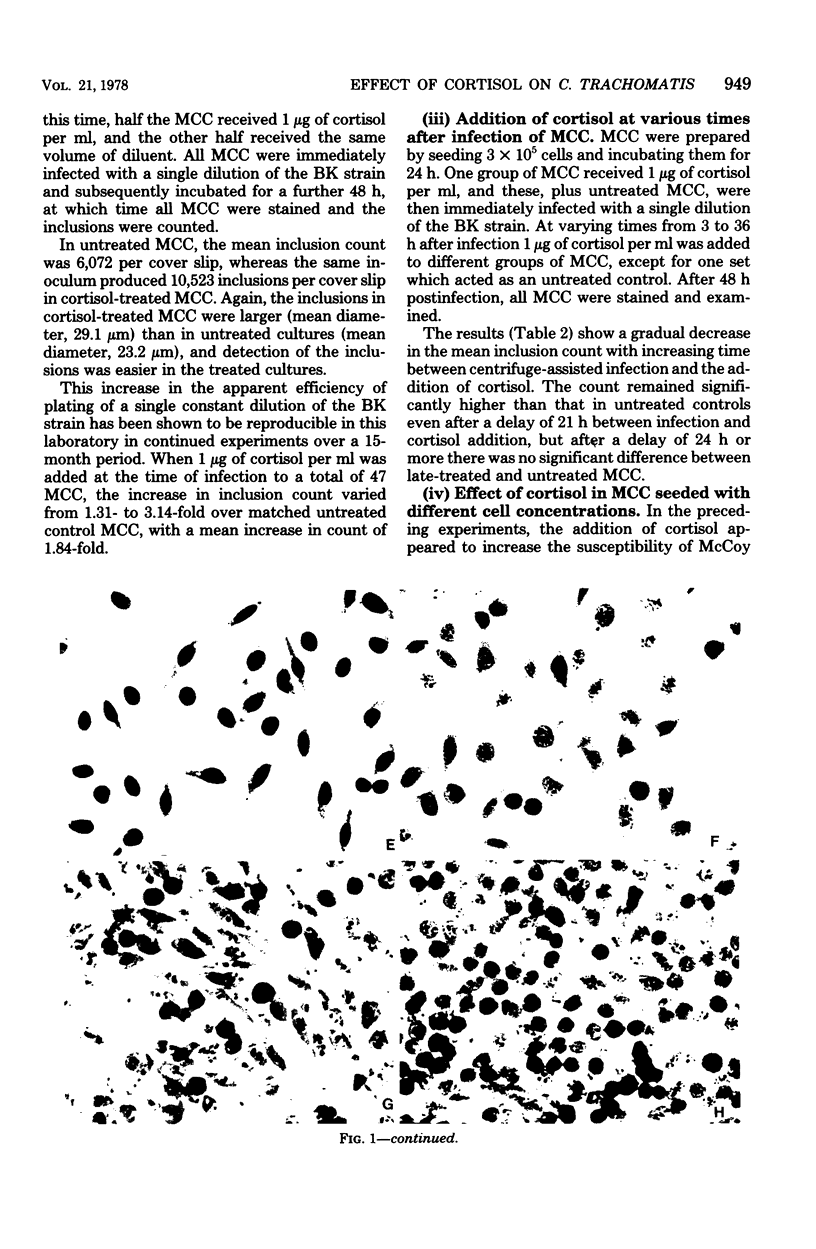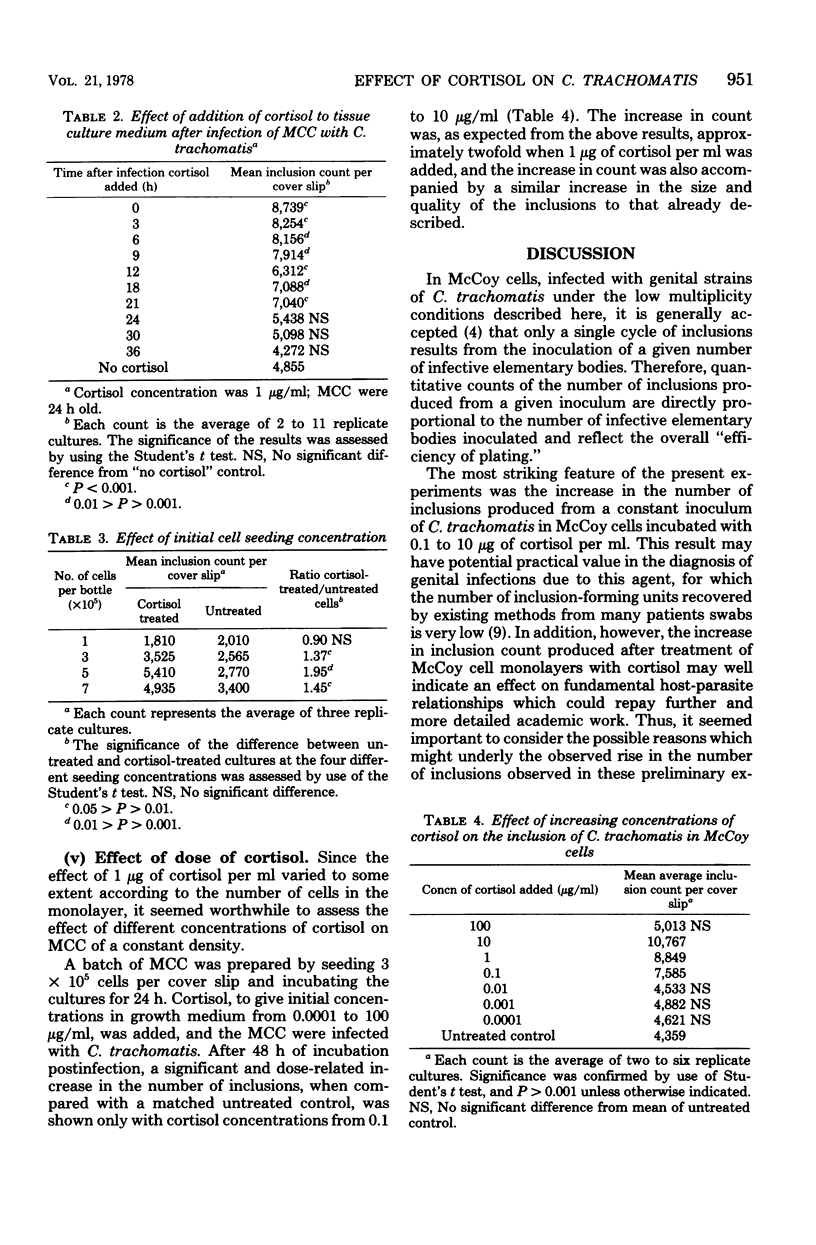Abstract
The number of intracytoplasmic inclusions of Chlamydia trachomatis produced in McCoy cell monolayer cultures infected with a constant inoculum of a recently isolated genital strain was compared in cultures of untreated replicating cells and in monolayers which had been incubated in the presence of cortisol at initial extracellular concentrations between 0.0001 and 100 microgram/ml. The effect of adding cortisol was dependent on its concentration, on the time of addition to the tissue culture medium, and on the initial number of McCoy cells seeded to form the monolayer. When a concentration of 1.0 microgram/ml was added at the time of infection with C. trachomatis, the number of inclusions detectable after a further 48 h of incubation was increased by 1.84-fold over those detected in untreated cells. The mean size of inclusions and the ease of their recognition in McCoy cell cultures was also increased by this procedure.
Full text
PDF







Images in this article
Selected References
These references are in PubMed. This may not be the complete list of references from this article.
- BOVARNICK M. R., MILLER J. C., SNYDER J. C. The influence of certain salts, amino acids, sugars, and proteins on the stability of rickettsiae. J Bacteriol. 1950 Apr;59(4):509–522. doi: 10.1128/jb.59.4.509-522.1950. [DOI] [PMC free article] [PubMed] [Google Scholar]
- Gordon F. B., Dressler H. R., Quan A. L., McQuilkin W. T., Thomas J. I. Effect of ionizing irradiation on susceptibility of McCoy cell cultures to Chlamydia trachomatis. Appl Microbiol. 1972 Jan;23(1):123–129. doi: 10.1128/am.23.1.123-129.1972. [DOI] [PMC free article] [PubMed] [Google Scholar]
- Hatch T. P. Competition between Chlamydia psittaci and L cells for host isoleucine pools: a limiting factor in chlamydial multiplication. Infect Immun. 1975 Jul;12(1):211–220. doi: 10.1128/iai.12.1.211-220.1975. [DOI] [PMC free article] [PubMed] [Google Scholar]
- Hilton A. L., Richmond S. J., Milne J. D., Hindley F., Clarke S. K. Chlamydia A in the female genital tract. Br J Vener Dis. 1974 Feb;50(1):1–10. doi: 10.1136/sti.50.1.1. [DOI] [PMC free article] [PubMed] [Google Scholar]
- Hobson D., Johnson F. W., Rees E., Tait I. A. Simplified method for diagnosis of genital and ocular infections with Chlamydia. Lancet. 1974 Sep 7;2(7880):555–556. doi: 10.1016/s0140-6736(74)91879-0. [DOI] [PubMed] [Google Scholar]
- Johnson F. W. A comparison of staining techniques for demonstrating group A chlamydia in tissue culture. Med Lab Technol. 1975 Jul;32(3):233–238. [PubMed] [Google Scholar]
- Johnson F. W., Hobson D. Factors affecting the sensitivity of replicating McCoy cells in the isolation and growth of chlamydia A (TRIC agents). J Hyg (Lond) 1976 Jun;76(3):441–451. doi: 10.1017/s0022172400055376. [DOI] [PMC free article] [PubMed] [Google Scholar]
- KILBOURNE E. D., TATENO I. In vitro effects of cortisone on multiplication of influenza B virus. Proc Soc Exp Biol Med. 1953 Feb;82(2):274–277. doi: 10.3181/00379727-82-20090. [DOI] [PubMed] [Google Scholar]
- Morhenn V., Rabinowitz Z., Tomkins G. M. Effects of adrenal glucocorticoids on polyoma virus replication. Proc Natl Acad Sci U S A. 1973 Apr;70(4):1088–1089. doi: 10.1073/pnas.70.4.1088. [DOI] [PMC free article] [PubMed] [Google Scholar]
- Paran M., Gallo R. C., Richardson L. S., Wu A. M. Adrenal corticosteroids enhance production of type-C virus induced by 5-iodo-2'-deoxyuridine from cultured mouse fibroblasts. Proc Natl Acad Sci U S A. 1973 Aug;70(8):2391–2395. doi: 10.1073/pnas.70.8.2391. [DOI] [PMC free article] [PubMed] [Google Scholar]
- Parks W. P., Ransom J. C., Young H. A., Scolnick E. M. Mammary tumor virus induction by glucocorticoids. Characterization of specific transcriptional regulation. J Biol Chem. 1975 May 10;250(9):3330–3336. [PubMed] [Google Scholar]
- Pratt W. B., Aronow L. The effect of glucocorticoids on protein and nucleic acid synthesis in mouse fibroblasts growing in vitro. J Biol Chem. 1966 Nov 25;241(22):5244–5250. [PubMed] [Google Scholar]
- SIGEL M. M., BEASLEY A. R. Demonstration of two effects of cortisone on virus-cell interaction. Proc Soc Exp Biol Med. 1955 Jan;88(1):86–89. doi: 10.3181/00379727-88-21499. [DOI] [PubMed] [Google Scholar]
- STEWART R. B. Effect of cortisone on the growth of psittacosis virus in cultures of L cells. J Bacteriol. 1960 Jul;80:25–29. doi: 10.1128/jb.80.1.25-29.1960. [DOI] [PMC free article] [PubMed] [Google Scholar]
- THOMAS L. Cortisone and infection. Ann N Y Acad Sci. 1953 Jul 17;56(4):799–814. doi: 10.1111/j.1749-6632.1953.tb27404.x. [DOI] [PubMed] [Google Scholar]
- Thompson E. B., Lippman M. E. Mechanism of action of glucocorticoids. Metabolism. 1974 Feb;23(2):159–202. doi: 10.1016/0026-0495(74)90113-9. [DOI] [PubMed] [Google Scholar]
- Todd W. J., Doughri A. M., Storz J. Ultrastructural changes in host cellular organelles in the course of the chlamydial developmental cycle. Zentralbl Bakteriol Orig A. 1976 Nov;236(2-3):359–373. [PubMed] [Google Scholar]





